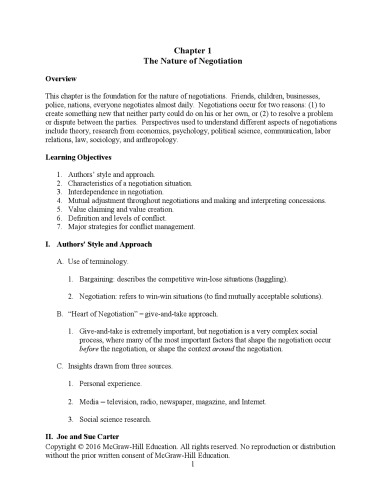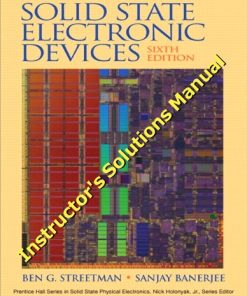(Ebook PDF) Essentials of Negotiation 2024 Release 6th Edition by Roy Lewicki 1260512592 9781260512595 full chapters
$50.00 Original price was: $50.00.$25.00Current price is: $25.00.
Essentials of Negotiation: 2024 Release 6th Edition by Roy J. Lewicki – Ebook PDF Instant Download/DeliveryISBN: 1260512592, 9781260512595
Full download Essentials of Negotiation: 2024 Release 6th Edition after payment.

Product details:
ISBN-10 : 1260512592
ISBN-13 : 9781260512595
Author: Roy J. Lewicki
Essentials of Negotiation, 7e is a condensed version of the main text, Negotiation, 8e. It explores the major concepts and theories of the psychology of bargaining and negotiation, and the dynamics of interpersonal and inter-group conflict and its resolution. Twelve of the 20 chapters from the main text have been included in this edition, several chapters having been condensed for this volume. Those condensed chapters have shifted from a more research-oriented focus to a more fundamental focus on issues such as critical negotiation sub processes, multiparty negotiations, and the influence of international and cross-cultural differences on the negotiation process.Accompanied by Connect®, and includes new SmartBook 2.0 to give your students a personalized reading and learning experience so they come to class more prepared. SmartBook 2.0 offers offline learning via a mobile device, required assignments, personalized review, and better accessibility.
Essentials of Negotiation: 2024 Release 6th Table of contents:
Chapter 1: The Nature of Negotiation
Chapter 1 Introduction
A Few Words about Our Style and Approach
Luis and Tracy Catalan
Characteristics of a Negotiation Situation
Interdependence
Types of Interdependence Affect Outcomes
Alternatives Shape Interdependence
Mutual Adjustment
Mutual Adjustment and Concession Making
Two Dilemmas in Mutual Adjustment
Value Claiming and Value Creation
Conflict
Definitions
Levels of Conflict
Functions and Dysfunctions of Conflict
Factors That Make Conflict Easy or Difficult to Manage
Effective Conflict Management
Overview of the Chapters in This Book
Endnotes
Chapter 2: Strategy and Tactics of Distributive Bargaining
Chapter 2 Introduction
The Distributive Bargaining Situation
The Role of Alternatives to a Negotiated Agreement
Settlement Point
Discovering the Other Party’s Resistance Point
Influencing the Other Party’s Resistance Point
Tactical Tasks
Assess the Other Party’s Target, Resistance Point, and Costs of Terminating Negotiations
Manage the Other Party’s Impressions of Your Target, Resistance Point, and Cost of Terminating Negotiations
Modify the Other Party’s Perceptions of Their Target, Resistance Point, and Cost of Terminating Negotiations
Manipulate the Actual Costs of Delaying or Terminating Negotiations
Positions Taken during Negotiation
Opening Offers
Opening Stance
Initial Concessions
Role of Concessions
Pattern of Concession Making
Final Offers
Closing the Deal
Provide Alternatives
Assume the Close
Split the Difference
Exploding Offers
Sweeteners
Hardball Tactics
Dealing with Typical Hardball Tactics
Typical Hardball Tactics
Chapter Summary
Endnotes
Chapter 3: Strategy and Tactics of Integrative Negotiation
Chapter 3 Introduction
An Overview of the Integrative Negotiation Process
Creating a Free Flow of Information
Attempting to Understand the Other Negotiator’s Real Needs and Objectives
Emphasizing Things in Common between the Parties and Minimizing the Differences
Searching for Solutions That Meet the Needs and Objectives of Both Sides
Key Steps in the Integrative Negotiation Process
Step 1: Identify and Define the Problem
Step 2: Surface Interests and Needs
Step 3: Generate Alternative Solutions
Step 4: Evaluate and Select Alternatives
Factors That Facilitate Successful Integrative Negotiation
Some Common Objective or Goal
Faith in One’s Problem-Solving Ability
A Belief in the Validity of One’s Own Position and the Other’s Perspective
The Motivation and Commitment to Work Together
Trust
Clear and Accurate Communication
An Understanding of the Dynamics of Integrative Negotiation
Chapter Summary
Endnotes
Chapter 4: Negotiation: Strategy and Planning
Chapter 4 Introduction
Goals—The Focus That Drives a Negotiation Strategy
Direct Effects of Goals on Choice of Strategy
Indirect Effects of Goals on Choice of Strategy
Strategy versus Tactics
Accommodation, Competition, and Collaboration
Getting Ready to Implement the Strategy: The Planning Process
1. Defining the Negotiating Goal
2. Defining the Major Issue Related to Achieving the Goal
3. Assembling the Issues, Ranking Their Importance, and Defining the Bargaining Mix
4. Defining the Interests
5. Knowing Your Alternatives (BATNAs)
6. Knowing Your Limits, Including a Resistance Point
7. Analyzing and Understanding the Other Party’s Goals, Issues, and Resistance Points
8. Setting One’s Own Targets and Opening Bids
9. Assessing the Social Context of Negotiation
10. Presenting the Issues to the Other Party: Substance and Process
Chapter Summary
Endnotes
Chapter 5: Ethics in Negotiation
Chapter 5 Introduction
A Sampling of Ethical Quandaries
What Do We Mean by “Ethics,” and Why Do They Matter in Negotiation?
Ethics Defined
Applying Ethical Reasoning to Negotiation
Ethics versus Prudence versus Practicality versus Legality
What Questions of Ethical Conduct Arise in Negotiation?
Ethically Ambiguous Tactics: It’s (Mostly) All about the Truth
Identifying Ethically Ambiguous Tactics and Attitudes toward Their Use
Deception by Omission versus Commission
The Decision to Use Ethically Ambiguous Tactics: A Model
Why Use Deceptive Tactics? Motives and Consequences
The Power Motive
Other Motives to Behave Unethically
The Consequences of Unethical Conduct
Explanations and Justifications
How Can Negotiators Deal with the Other Party’s Use of Deception?
Chapter Summary
Endnotes
Chapter 6: Perception, Cognition, and Emotion
Chapter 6 Introduction
Perception
Perception Defined
Perceptual Distortion
Framing
Types of Frames
How Frames Work in Negotiation
Another Approach to Frames: Interests, Rights, and Power
The Frame of an Issue Changes as the Negotiation Evolves
Cognitive Biases in Negotiation
1. Irrational Escalation of Commitment
2. Mythical Fixed-Pie Beliefs
3. Anchoring and Adjustment
4. Issue Framing and Risk
5. Availability of Information
6. The Winner’s Curse
7. Overconfidence
8. The Law of Small Numbers
9. Self-Serving Biases
10. Endowment Effect
11. Ignoring Others’ Cognitions
12. Reactive Devaluation
Managing Misperceptions and Cognitive Biases in Negotiation
Mood, Emotion, and Negotiation
Chapter Summary
Endnotes
Chapter 7: Communication
Chapter 7 Introduction
What Is Communicated during Negotiation?
1. Offers and Counteroffers
2. Information about Alternatives
3. Information about Outcomes
4. Social Accounts
5. Communication about Process
Are Negotiators Consistent or Adaptive?
Does It Matter What Is Said Early in the Negotiation?
Is More Information Always Better?
How People Communicate in Negotiation
Characteristics of Language
Use of Nonverbal Communication
Selection of a Communication Channel
How to Improve Communication in Negotiation
The Use of Questions
Listening
Role Reversal
Chapter Summary
Endnotes
Chapter 8: Power and Influence in Negotiation
Chapter 8 Introduction
Why Is Power Important to Negotiators?
Sources of Power—How People Acquire Power
Informational Sources of Power
Power Based on Personality and Individual Differences
Power Based on Position in an Organization (Structural Power)
Power Based on Relationships
Contextual Sources of Power
Dealing with Others Who Have More Power
Influence: Power in Action
Two Routes to Influence: An Organizing Model
The Central Route to Influence: The Message and Its Delivery
Peripheral Routes to Influence
The Role of Receivers—Targets of Influence
Chapter Summary
Endnotes
Chapter 9: Relationships in Negotiation
Chapter 9 Introduction
Does Our Understanding of Negotiation Apply to Negotiating in Long—Term Relationships?
Negotiations in Communal Sharing Relationships
Key Elements in Managing Negotiations within Relationships
Reputation
Trust
Justice
Relationships among Reputation, Trust, and Justice
Repairing a Relationship
Chapter Summary
Endnotes
Chapter 10: Multiple Parties and Groups in Negotiations
Chapter 10 Introduction
The Nature of Multiparty Negotiations
Differences between Two-Party Negotiations and Multiparty Negotiations
What Dynamics Can Make a Multiparty Negotiation Effective?
Managing Multiparty Negotiations
The Prenegotiation Stage
The Formal Negotiation Stage—Managing the Process and Outcome
The Agreement Stage
Chapter Summary
Endnotes
Chapter 11: International and Cross-Cultural Negotiation
Chapter 11 Introduction
What Makes International Negotiation Different?
Environmental Context
Immediate Context
Conceptualizing Culture and Negotiation
Culture as Shared Values
Cultural Syndromes and Logics
Cultural Tightness-Looseness
Culture as Learned Behavior
Culture in Context
The Influence of Culture on Negotiation: Managerial Perspectives
Definition of Negotiation
Negotiation Opportunity
Selection of Negotiators
Protocol
Communication
Time Sensitivity
Risk Propensity
Groups versus Individuals
Nature of Agreements
Emotionalism
The Influence of Culture on Negotiation: Research Perspectives
Effects of Culture on Negotiation Outcomes
Effects of Culture on Negotiation Process and Information Exchange
Effects of Culture on Negotiator Cognition
Effects of Culture on Negotiator Ethics and Tactics
Culturally Responsive Negotiation Strategies
Weiss’s Culturally Responsive Strategies
Chapter Summary
Endnotes
Chapter 12: Best Practices in Negotiations
People also search for Essentials of Negotiation: 2024 Release 6th
essentials of negotiation
essentials of negotiation 7th edition pdf
essentials of negotiation 7th edition
essentials of negotiation 7th edition pdf free download
borrow essentials of negotiation
Tags:
Essentials,Negotiation,Roy Lewicki,psychology,interpersonal
You may also like…
Uncategorized
Business & Economics - Management & Leadership
Business & Economics - Management & Leadership
Business & Economics - Management & Leadership
Business & Economics - Management & Leadership
Engineering - Electrical & Electronic Engineering





![Textbook of Clinical Echocardiography, 6e [Lingua inglese] 6th Edition Otto](https://ebookmass.com/wp-content/uploads/2024/04/textbook-of-clinical-echocardiography-6e-lingua-inglese-11006250-247x296.jpg)






